Tilted Beam Fabry–Perot Antenna with Enhanced Gain and Broadband Low Backscattering
Abstract
1. Introduction
2. Proposed Antenna System and Its Operation
2.1. Fabry–Perot (F-P) Cavity Antenna
2.2. Unit Cell Configuration
2.3. Parametric Analysis
3. Simulation Results and Experimental Validation
3.1. Antenna Results
3.2. Scattering Results
4. Discussion
5. Conclusions
Author Contributions
Funding
Conflicts of Interest
References
- Wilsen, C.; Davidson, D. The radar cross section reduction of microstrip patches. In Proceedings of the IEEE, AFRICON’96, Stellenbosch, South Africa, 27 September 1996; pp. 730–733. [Google Scholar]
- Wiesbeck, W.; Heidrich, E. Influence of antennas on the radar cross section of camouflaged aircraft. In Proceedings of the 92 International Conference on Radar, Brighton, UK, 12–13 October 1992; pp. 122–125. [Google Scholar]
- Chen, Q.; Fu, Y. A planar stealthy antenna radome using absorptive frequency selective surface. Microw. Opt. Technol. Lett. 2014, 56, 1788–1792. [Google Scholar] [CrossRef]
- Costa, F.; Monorchio, A. A Frequency Selective Radome with Wideband Absorbing Properties. IEEE Trans. Antennas Propag. 2012, 60, 2740–2747. [Google Scholar] [CrossRef]
- Thummaluru, S.R.; Chaudhary, R.K. Reducing the RCS of MIMO Antenna using Angularly Stable FSS. In Proceedings of the 2019 URSI Asia-Pacific Radio Science Conference (AP-RASC), New Delhi, India, 9–15 March 2019; pp. 1–4. [Google Scholar]
- Thummaluru, S.R.; Kumar, R.; Chaudhary, R.K. Isolation enhancement and radar cross section reduction of MIMO antenna with frequency selective surface. IEEE Trans. Antennas Propag. 2018, 66, 1595–1600. [Google Scholar] [CrossRef]
- Genovesi, S.; Costa, F.; Monorchio, A. Low-Profile Array with Reduced Radar Cross Section by Using Hybrid Frequency Selective Surfaces. IEEE Trans. Antennas Propag. 2012, 60, 2327–2335. [Google Scholar] [CrossRef]
- Xue, J.; Jiang, W.; Gong, S. Wideband RCS reduction of microstrip array antenna based on absorptive frequency selective surface and microstrip resonators. Int. J. Antennas Propag. 2017, 2017, 1–11. [Google Scholar] [CrossRef]
- Long, M.; Jiang, W.; Gong, S. Double-layer miniaturised-element metasurface for RCS reduction. IET Microw. Antennas Propag. 2016, 11, 705–710. [Google Scholar] [CrossRef]
- Pan, W.; Huang, C.; Chen, P.; Ma, X.; Hu, C.; Luo, X. A Low-RCS and High-Gain Partially Reflecting Surface Antenna. IEEE Trans. Antennas Propag. 2014, 62, 945–949. [Google Scholar] [CrossRef]
- Cong, L.-L.; Cao, X.-Y.; Li, W.; Zhao, Y. A new design method for patch antenna with low RCS and high gain performance. Prog. Electromagn. Res. 2016, 59, 77–84. [Google Scholar] [CrossRef]
- Mu, J.; Wang, H.; Wang, H.; Huang, Y. Low-RCS and gain enhancement design of a novel partially reflecting and absorbing surface antenna. IEEE Antennas Wirel. Propag. Lett. 2017, 16, 1903–1906. [Google Scholar] [CrossRef]
- Huang, C.; Pan, W.; Ma, X.; Luo, X. A Frequency Reconfigurable Directive Antenna with Wideband Low-RCS Property. IEEE Trans. Antennas Propag. 2016, 64, 1173–1178. [Google Scholar] [CrossRef]
- Ourir, A.; Burokur, S.; De Lustrac, A. Electronically reconfigurable metamaterial for compact directive cavity antennas. Electron. Lett. 2007, 43, 698–700. [Google Scholar] [CrossRef]
- Jia, Y.; Liu, Y.; Zhang, W.; Wang, J.; Gong, S.; Liao, G. High-Gain Fabry-Perot Antennas with Wideband Low Monostatic RCS Using Phase Gradient Metasurface. IEEE Access 2019, 7, 4816–4824. [Google Scholar] [CrossRef]
- Dadgarpour, A.; Zarghooni, B.; Virdee, B.S.; Denidni, T.A. Beam Tilting Antenna Using Integrated Metamaterial Loading. IEEE Trans. Antennas Propag. 2014, 62, 2874–2879. [Google Scholar] [CrossRef]
- Mehmood, A.; Karabey, O.H.; Jakoby, R. Dielectric Resonator Antenna with Tilted Beam. IEEE Antennas Wirel. Propag. Lett. 2016, 16, 1119–1122. [Google Scholar] [CrossRef]
- Sumantyo, J.T.S. Design of tilted beam circularly polarized antenna for CP-SAR sensor onboard UAV. In Proceedings of the 2016 International Symposium on Antennas and Propagation (ISAP), Okinawa, Japan, 24–28 October 2016; pp. 658–659. [Google Scholar]
- Ourir, A.; Burokur, S.; de Lustrac, A. Phase-varying metamaterial for compact steerable directive antennas. Electron. Lett. 2007, 43, 493–494. [Google Scholar] [CrossRef]
- Nakano, H.; Mitsui, S.; Yamauchi, J. Tilted-beam high gain antenna system composed of a patch antenna and periodically arrayed loops. IEEE Trans. Antennas Propag. 2014, 62, 2917–2925. [Google Scholar] [CrossRef]
- Katare, K.K.; Chandravanshi, S.; Biswas, A.; Akhtar, M.J. Beam-switching of Fabry–Perot cavity antenna using asymmetric reflection phase response of bianisotropic metasurface. IET Microw. Antennas Propag. 2019, 13, 842–848. [Google Scholar] [CrossRef]
- BChacko, P.; Augustin, G.; Denidni, T.A. Tilted-beam superstrate antenna with low-profile and high-gain. In Proceedings of the 2016 IEEE International Symposium on Antennas and Propagation (APSURSI), Fajardo, Puerto, 26 June–1 July 2016; pp. 341–342. [Google Scholar]
- Oyan, M.J.; Hamran, S.-E.; Damsgard, L.; Berger, T. Compact Airborne C-Band Radar Sounder. IEEE Trans. Geosci. Remote. Sens. 2014, 52, 6326–6332. [Google Scholar] [CrossRef]
- Foroozesh, A.; Shafai, L. Investigation into the effects of the patch-type FSS superstrate on the high-gain cavity resonance antenna design. IEEE Trans. Antennas Propag. 2009, 58, 258–270. [Google Scholar] [CrossRef]
- Costa, F.; Monorchio, A.; Manara, G. Analysis and Design of Ultra Thin Electromagnetic Absorbers Comprising Resistively Loaded High Impedance Surfaces. IEEE Trans. Antennas Propag. 2010, 58, 1551–1558. [Google Scholar] [CrossRef]
- Landy, N.I.; Sajuyigbe, S.; Mock, J.J.; Smith, D.R.; Padilla, W.J. Perfect Metamaterial Absorber. Phys. Rev. Lett. 2008, 100, 207402. [Google Scholar] [CrossRef] [PubMed]
- Jiang, H.; Xue, Z.; Li, W.; Ren, W.; Cao, M. Low-RCS High-Gain Partially Reflecting Surface Antenna with Metamaterial Ground Plane. IEEE Trans. Antennas Propag. 2016, 64, 4127–4132. [Google Scholar] [CrossRef]
- Ratni, B.; Merzouk, W.A.; De Lustrac, A.; Villers, S.; Piau, G.-P.; Burokur, S. Design of Phase-Modulated Metasurfaces for Beam Steering in Fabry–Perot Cavity Antennas. IEEE Antennas Wirel. Propag. Lett. 2017, 16, 1401–1404. [Google Scholar] [CrossRef]
- Ji, L.-Y.; Guo, Y.J.; Qin, P.-Y.; Gong, S.-X.; Mittra, R. A Reconfigurable Partially Reflective Surface (PRS) Antenna for Beam Steering. IEEE Trans. Antennas Propag. 2015, 63, 2387–2395. [Google Scholar] [CrossRef]
- Mailloux, R.J. Phased Array Antenna Handbook; Artech House: Norwood, MA, USA, 2017. [Google Scholar]
- Hassan, T.; Khan, M.U.; Attia, H.; Sharawi, M.S. An FSS Based Correlation Reduction Technique for MIMO Antennas. IEEE Trans. Antennas Propag. 2018, 66, 4900–4905. [Google Scholar] [CrossRef]
- Zhang, L.; Wan, X.; Liu, S.; Yin, J.Y.; Zhang, Q.; Wu, H.T.; Cui, T.J. Realization of low scattering for a high-gain Fabry–Perot antenna using coding metasurface. IEEE Trans. Antennas Propag. 2017, 65, 3374–3383. [Google Scholar] [CrossRef]
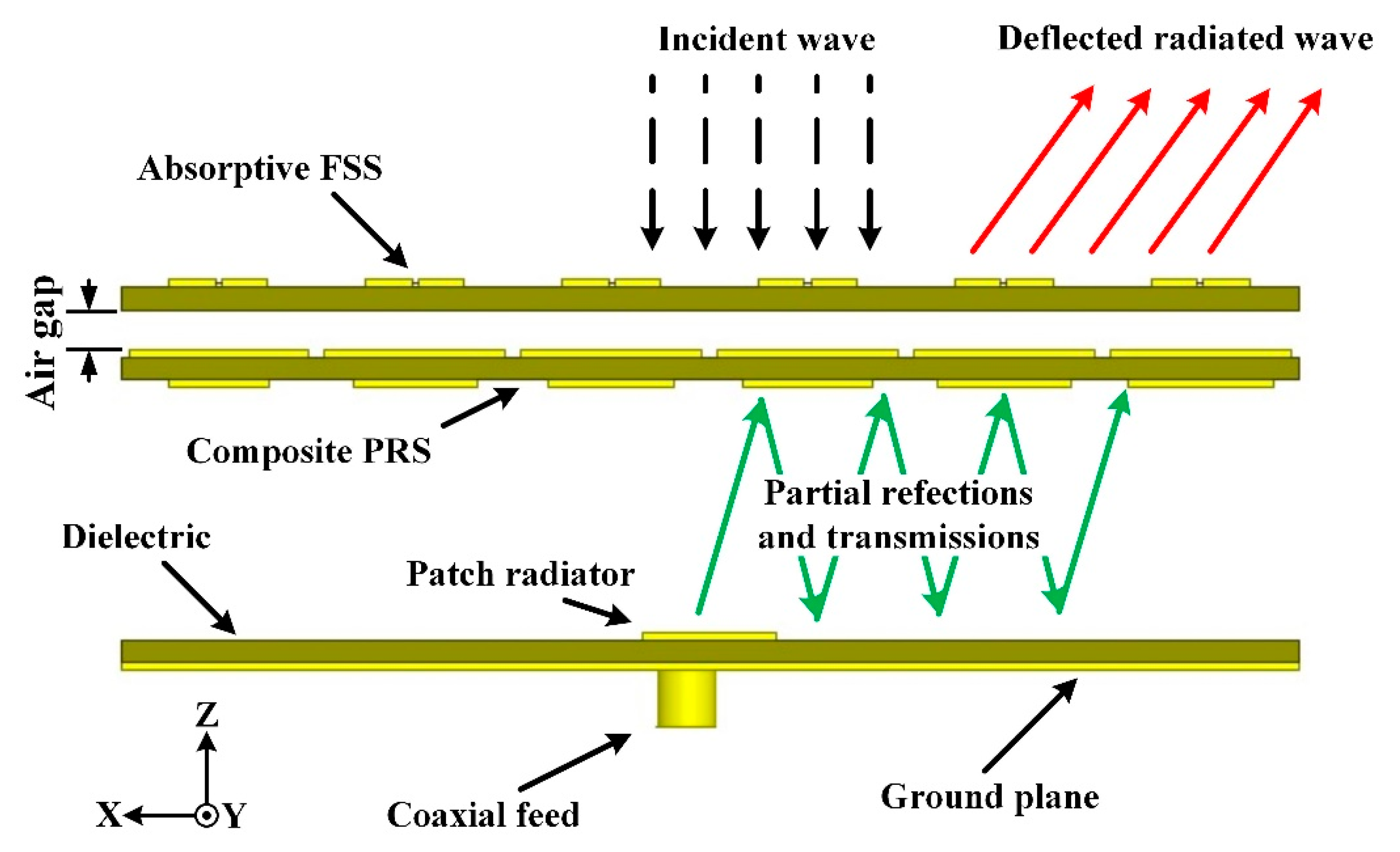




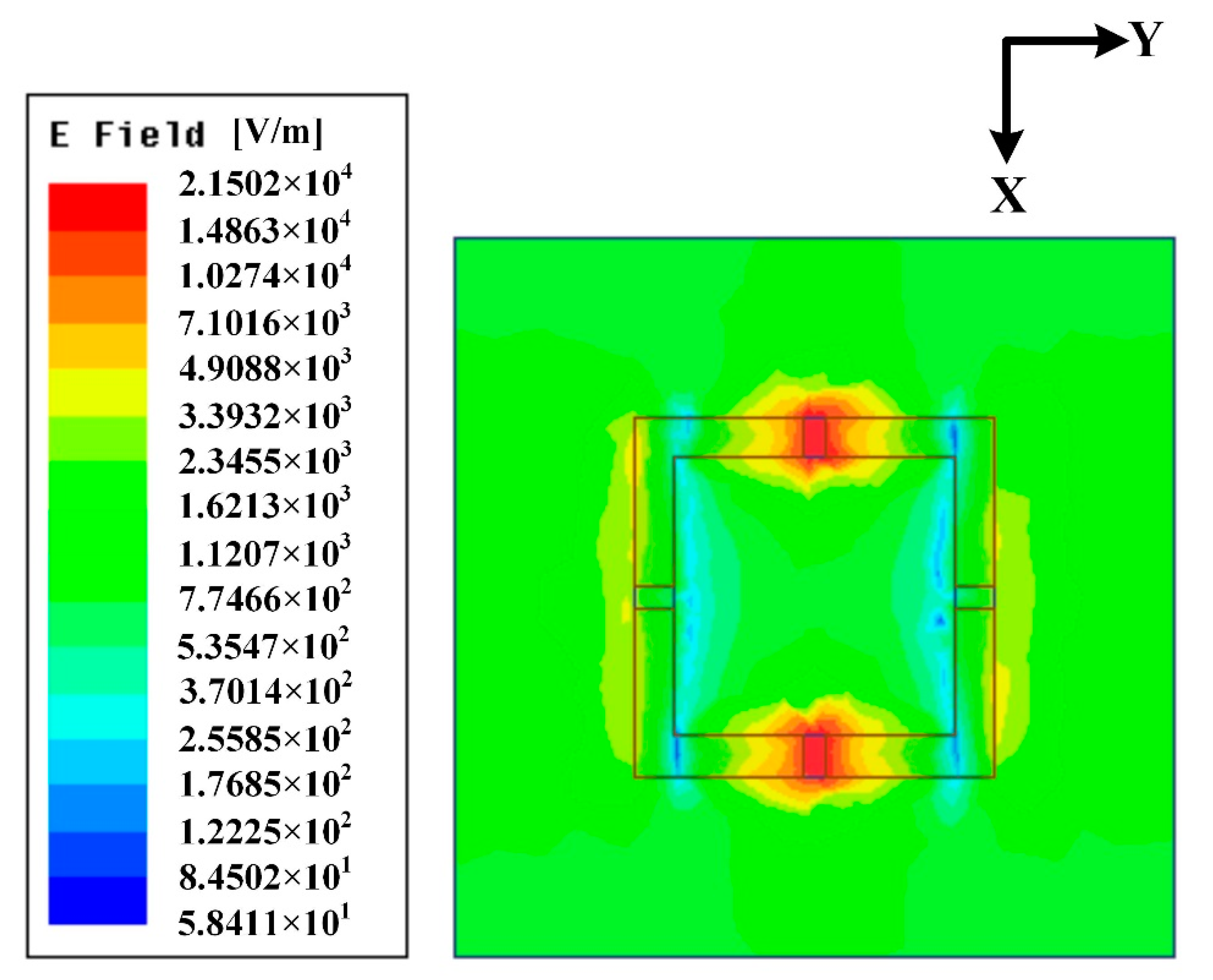

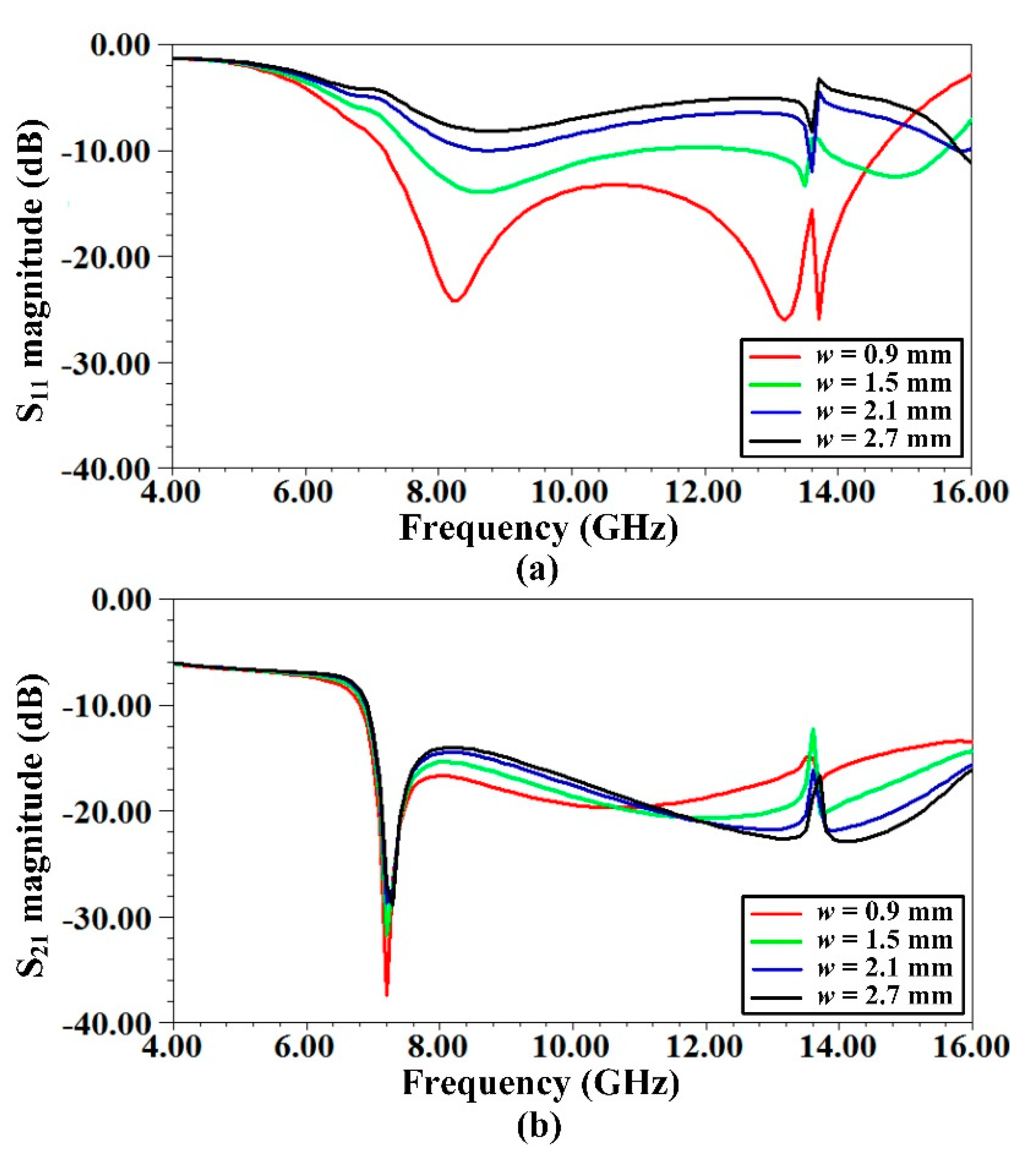

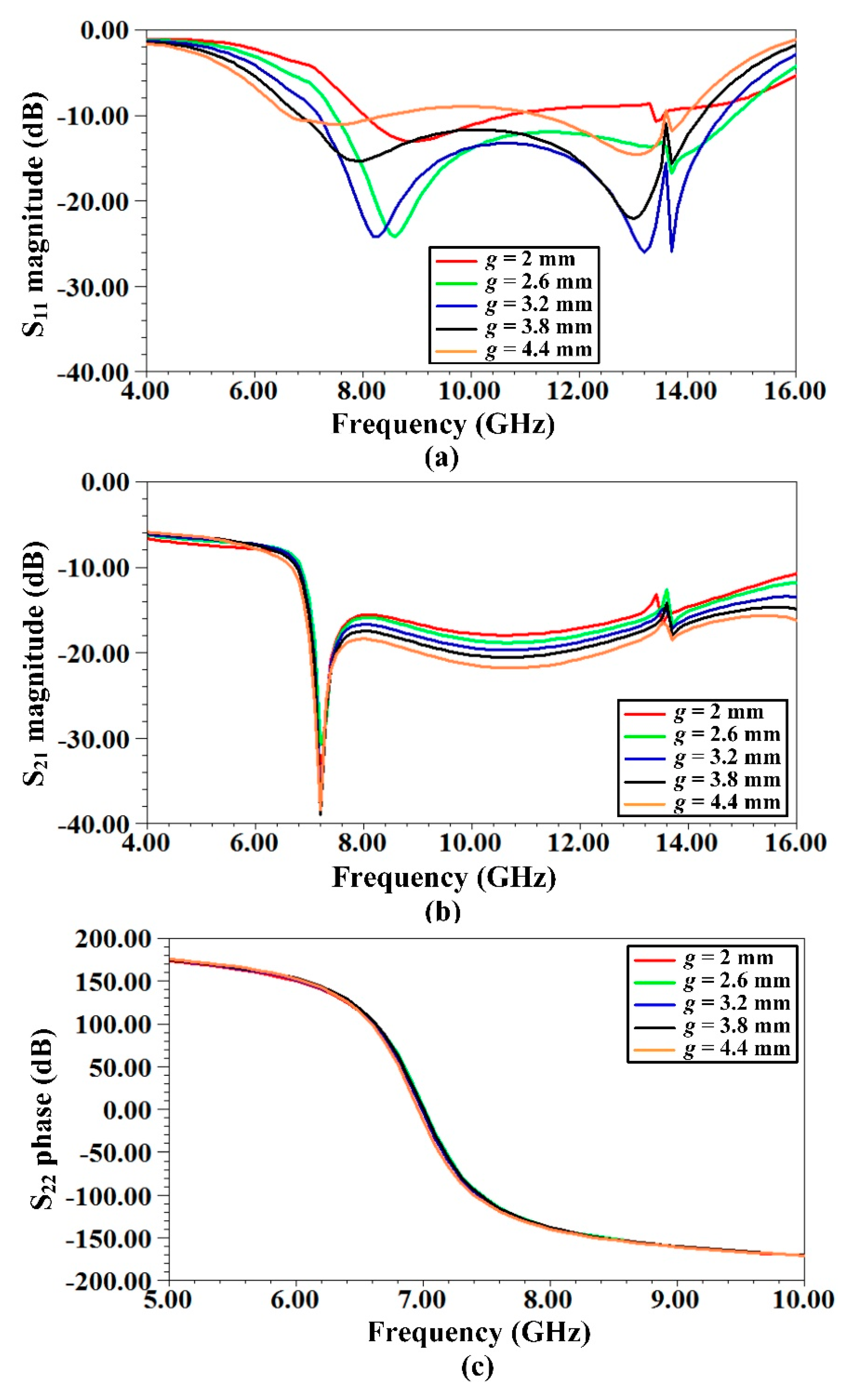
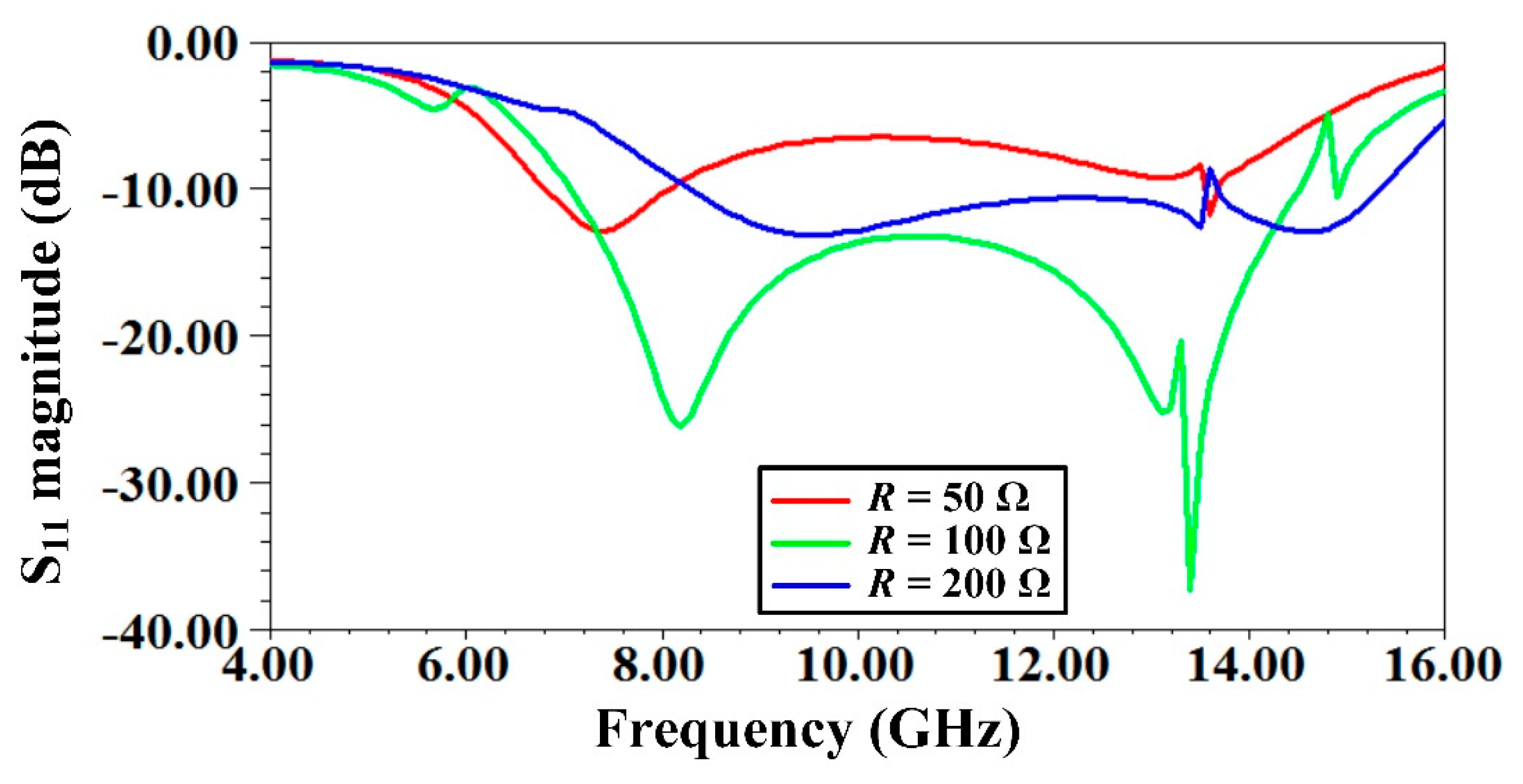
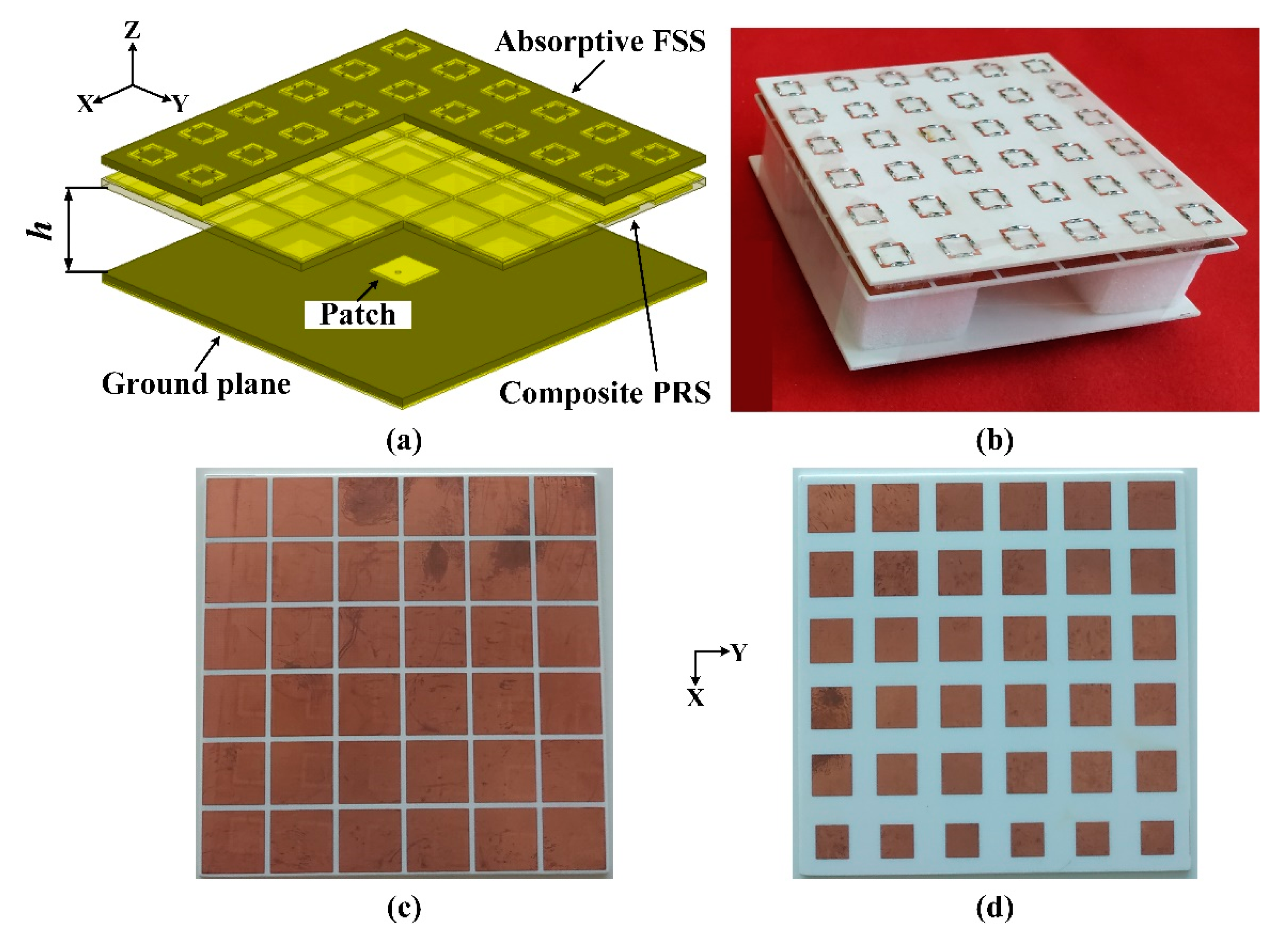
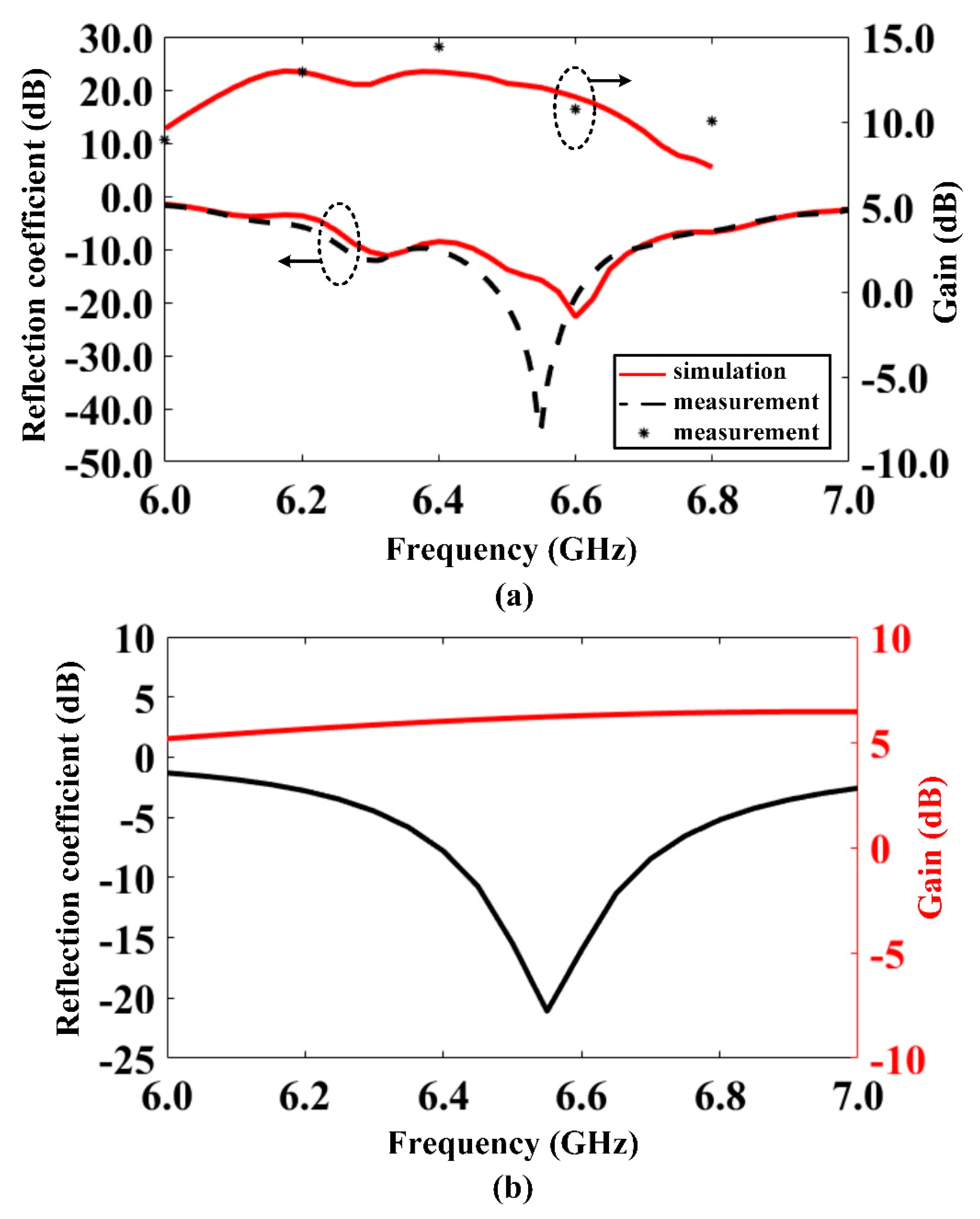
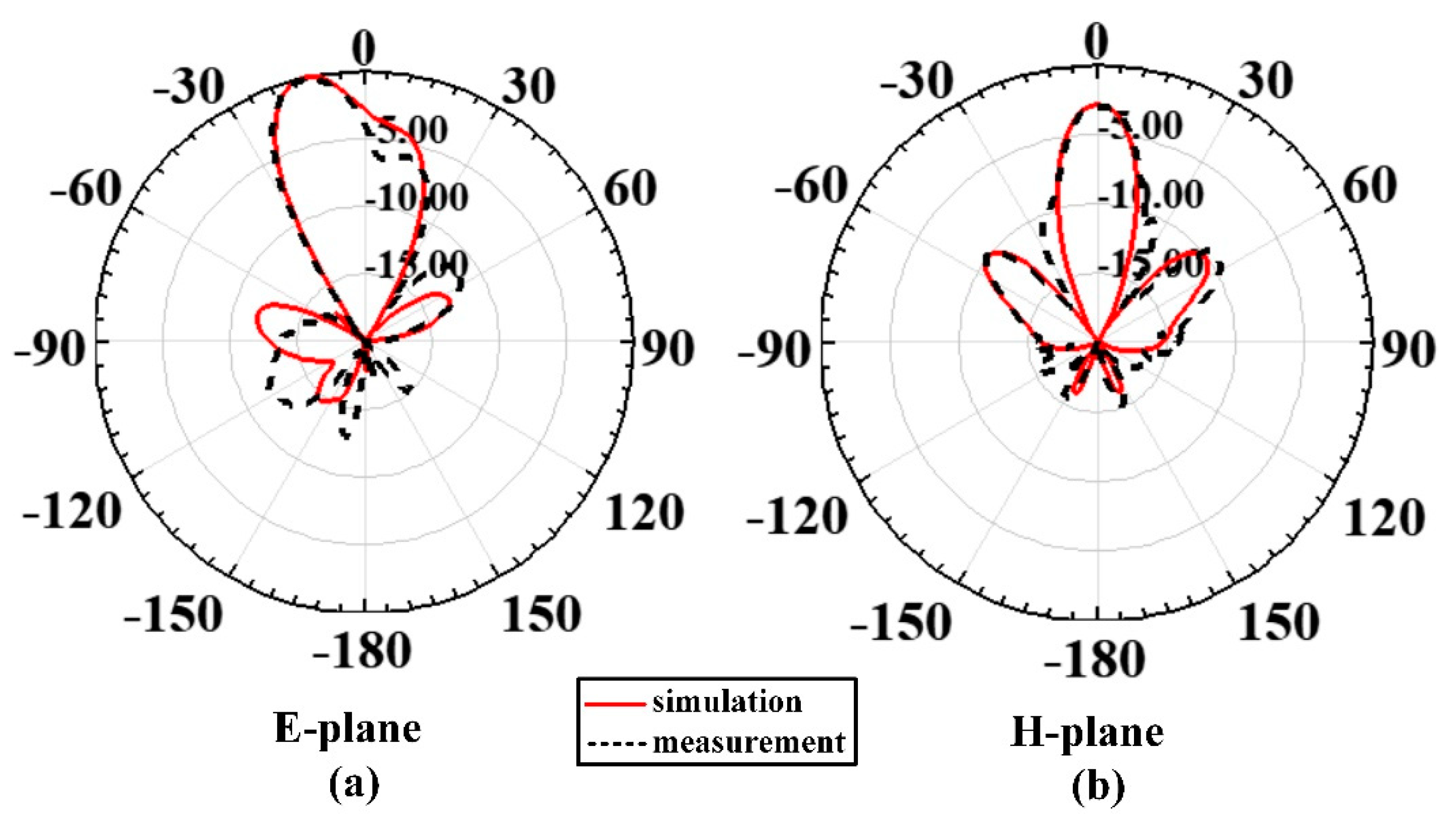


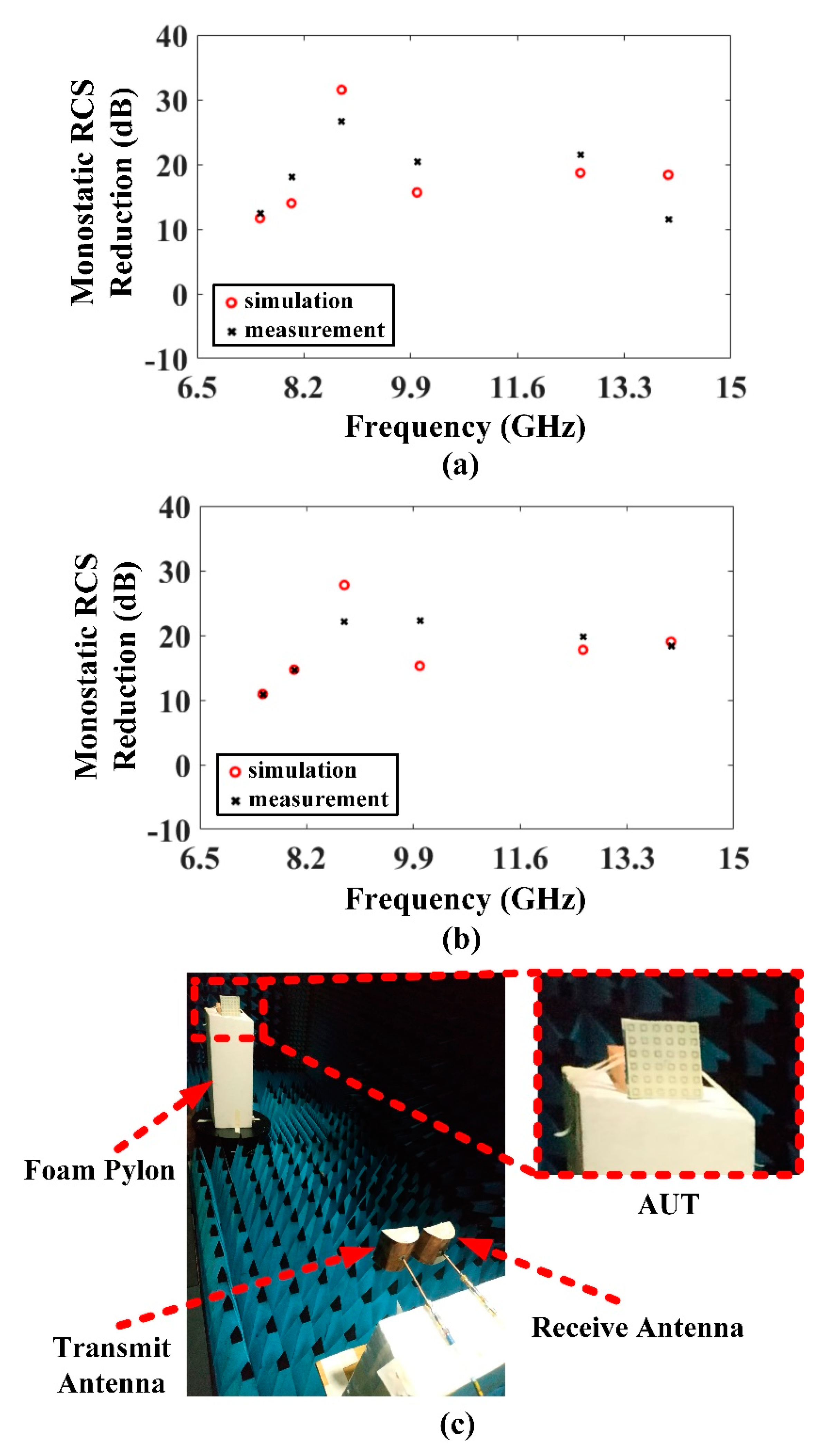
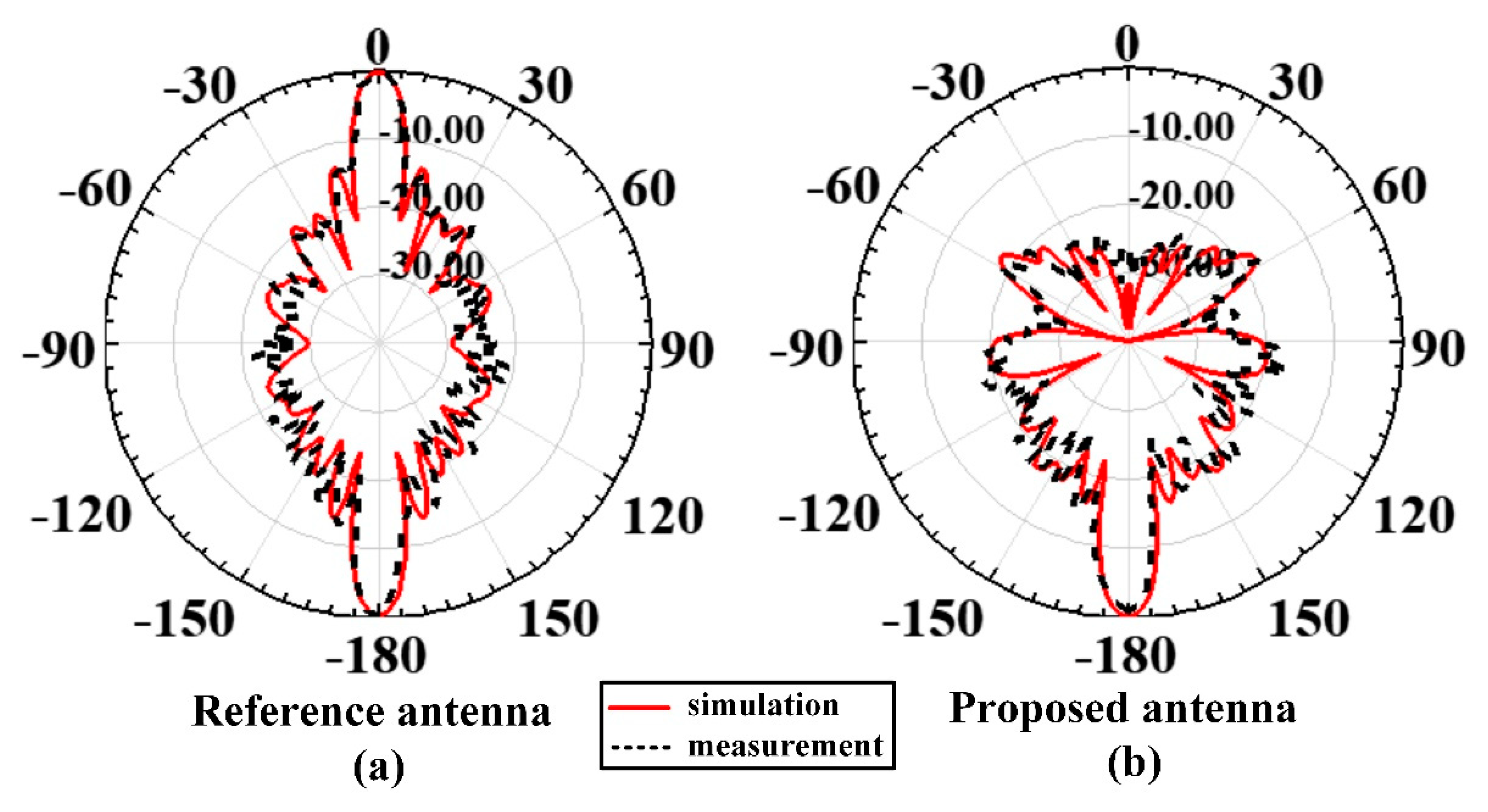
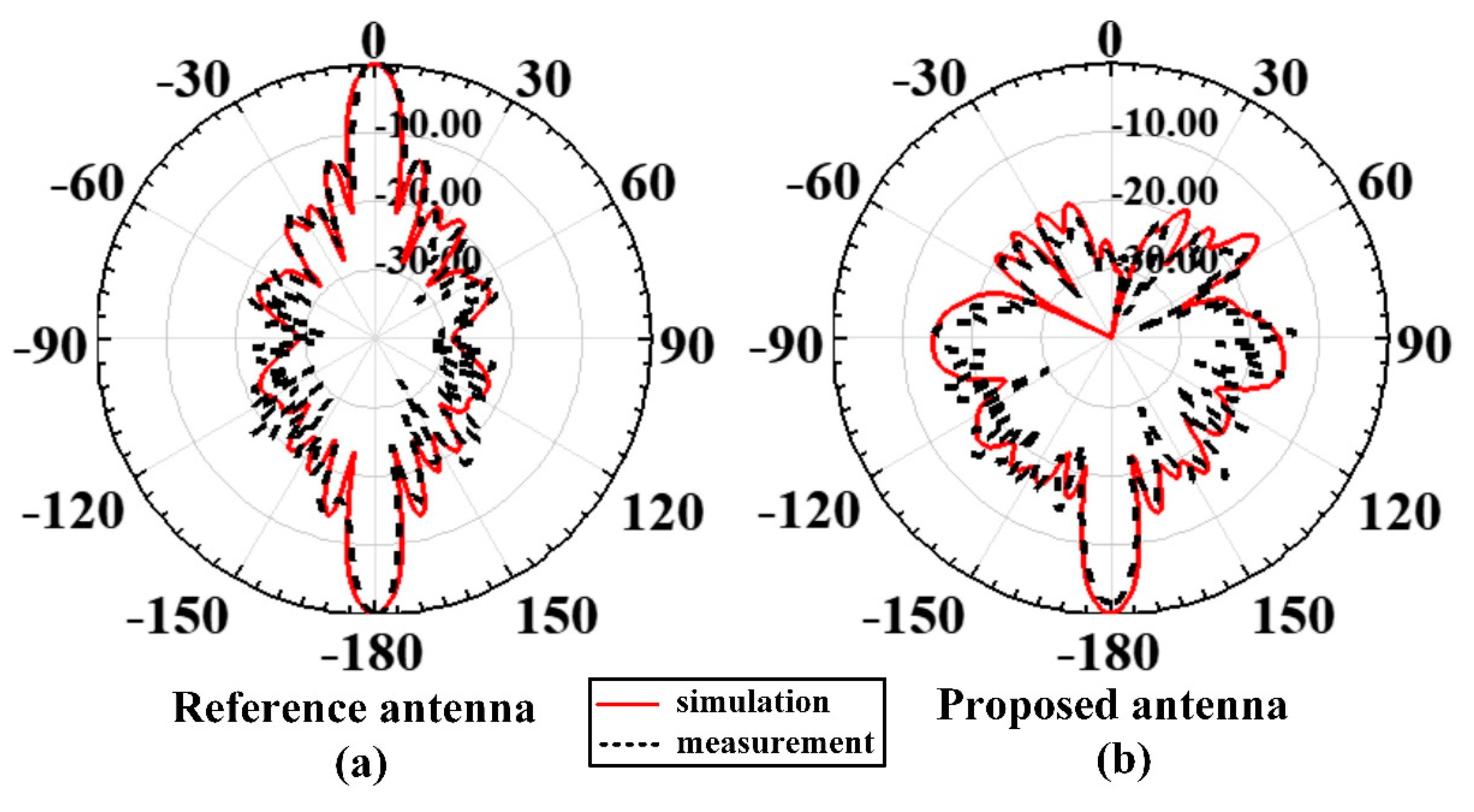
| Parameter | g | m | l | w | r | p | h | v | R |
|---|---|---|---|---|---|---|---|---|---|
| Value | 3.2 | 16 | 8 | 0.9 | 0.5 | 14.7 | 20 | variable | 100 Ω |
| Gradient Patch Lengths (mm) | 8.2 | 10 | 10.2 | 10.7 | 11 | 11.8 |
| Reflection Phase Values | 158.51° | 105.61° | 88.37° | −27.28° | −83.8° | −125.03° |
| S. No. | Frequency Points (GHz) | RCS Reduction (dB) | |||
|---|---|---|---|---|---|
| x-pol Simulated | x-pol Measured | y-pol Simulated | y-pol Measured | ||
| 1. | 7.5 | 11.67 | 12.4 | 10.92 | 10.87 |
| 2. | 8 | 13.99 | 18.12 | 14.69 | 14.62 |
| 3. | 8.8 | 31.53 | 26.65 | 27.77 | 22.09 |
| 4. | 10 | 15.66 | 20.32 | 15.27 | 22.23 |
| 5. | 12.6 | 18.68 | 21.49 | 17.76 | 19.82 |
| 6. | 14 | 18.38 | 11.48 | 19 | 18.37 |
| Average RCS Reduction (dB) | 18.32 | 18.41 | 17.57 | 18 | |
| Ref. | Aperture Size/Cavity Height | Center Frequency | Gain | RCS Band/Bandwidth | Average RCS Suppression | Peak Radiation |
|---|---|---|---|---|---|---|
| [10] | 2.3 λ × 2.3 λ/0.58 λ | 11.5 GHz | 13.2 dBi | 6–14 GHz (8 GHz) | 10 dB | 0° |
| [27] | 3.7 λ × 3.7 λ/0.73 λ | 10 GHz | 18.4 dBi | 8–17 GHz (9 GHz) | 13 dB | 0° |
| [12] | 2.53 λ × 2.53 λ/0.67 λ | 7.65 GHz | 12.3 dBi | 5–13 GHz (8 GHz) | not given | 0° |
| [15] (a) 1 | 3.36 λ × 3.36 λ/0.7 λ | 8.4 GHz | 19.2 dBi | 7–11 GHz (4 GHz) | 6.4 dB | 0° |
| [15] (b) 1 | 3.36 λ × 3.36 λ/0.7 λ | 8.4 GHz | 17.9 dBi | 7–15 GHz (8 GHz) | 9.9 dB | 0° |
| [32] | 3.67 λ × 3.67 λ/0.62 λ | 10 GHz | 19.8 dBi | 8–12 GHz (4 GHz) | 8.76 dB | 0° |
| [13] | 2.79 λ × 2.79 λ/0.68 λ | Reconfigurable 9.05–10 GHz | 13.7 dBi | 7–14 GHz (7 GHz) | not given | 0° |
| This work | 2.11 λ × 2.11 λ/0.44 λ | 6 GHz | 11.5 dBi | 5.6–16 GHz (10.4 GHz) | 13 dB | 13° |
Publisher’s Note: MDPI stays neutral with regard to jurisdictional claims in published maps and institutional affiliations. |
© 2021 by the authors. Licensee MDPI, Basel, Switzerland. This article is an open access article distributed under the terms and conditions of the Creative Commons Attribution (CC BY) license (http://creativecommons.org/licenses/by/4.0/).
Share and Cite
Umair, H.; Latef, T.B.A.; Yamada, Y.; Mahadi, W.N.L.B.W.; Othman, M.; Kamardin, K.; Hussein, M.I.; Najam, A.I. Tilted Beam Fabry–Perot Antenna with Enhanced Gain and Broadband Low Backscattering. Electronics 2021, 10, 267. https://doi.org/10.3390/electronics10030267
Umair H, Latef TBA, Yamada Y, Mahadi WNLBW, Othman M, Kamardin K, Hussein MI, Najam AI. Tilted Beam Fabry–Perot Antenna with Enhanced Gain and Broadband Low Backscattering. Electronics. 2021; 10(3):267. https://doi.org/10.3390/electronics10030267
Chicago/Turabian StyleUmair, Hassan, Tarik Bin Abdul Latef, Yoshihide Yamada, Wan Nor Liza Binti Wan Mahadi, Mohamadariff Othman, Kamilia Kamardin, Mousa I. Hussein, and Ali Imran Najam. 2021. "Tilted Beam Fabry–Perot Antenna with Enhanced Gain and Broadband Low Backscattering" Electronics 10, no. 3: 267. https://doi.org/10.3390/electronics10030267
APA StyleUmair, H., Latef, T. B. A., Yamada, Y., Mahadi, W. N. L. B. W., Othman, M., Kamardin, K., Hussein, M. I., & Najam, A. I. (2021). Tilted Beam Fabry–Perot Antenna with Enhanced Gain and Broadband Low Backscattering. Electronics, 10(3), 267. https://doi.org/10.3390/electronics10030267






